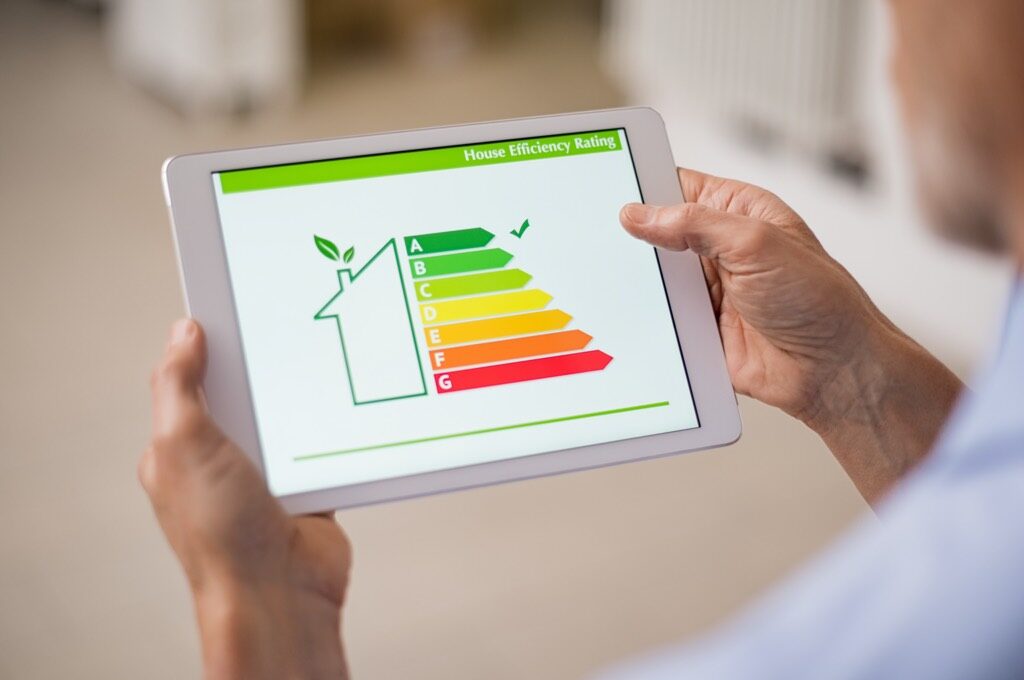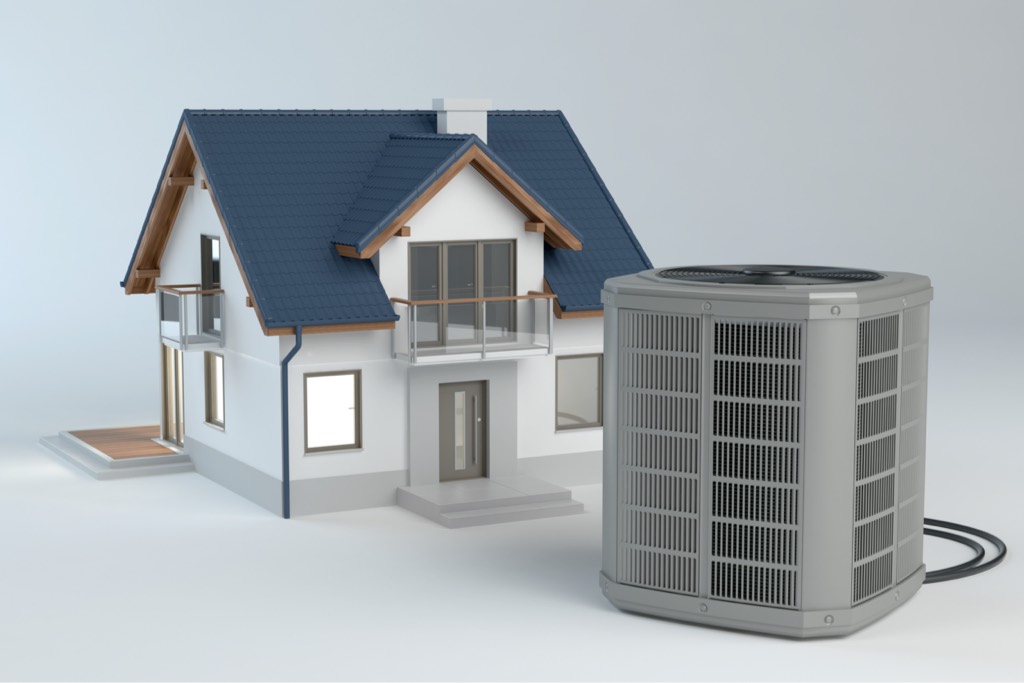How does a heat pump work?
In order to understand air source vs ground source heat pumps, we need to consider how heatings systems work. All heating systems require the same thing – heat. A traditional heating system uses a boiler. Gas burns to heat water in your central heating pipes while electricity heats water using electric elements.
In contrast, a heat pump system harnesses heat from the world around us. This can be from the air or from the ground. The pump then concentrates and increases that heat to the point where it can adequately heat a house. This heat is already readily available as its original source is the sun. It doesn’t require non-renewable resources to be produced. It is also certain to be future-proofed, even when other resources are running low.
What types of heat pumps are there?
Whether it’s an air source or a ground source heat pump, the basic process underpinning how they work is the same. They use natural heat from the world around us to heat our homes. But the way that they achieve this differs between the various types of heat pumps, as they use different sources to harness heat. So, what types of heat pumps are available?
Air source heat pumps
These heat pumps extract heat from the air outside your house. In the same way as a refrigerator takes heat from its interior and releases it outside, an air source heat pump takes heat from outside your house and releases it inside the home. This works even in temperatures as low as -15°C. They are still able to harness heat from the air and process it in such a way that it compresses the heat and warms the house. For a more detailed explanation of how air source heat pumps work, you can read our article here.
Air-to-air systems transfer the heat through a fan to heat the home. Air-to-water systems use water to absorb the heat. This runs in central heating pipes which heat the house through radiators and underfloor heating. Air-to-water systems can also supply domestic hot water through taps and showers.
Ground source heat pumps
These heat pumps take advantage of the stable underground temperature below the earth’s surface. Just one metre under our feet, the temperature of the earth is always between 8 and 12°C, no matter what the weather conditions are above ground.
Ground source heat pumps harness the heat from the ground through a system of pipes. These are filled with thermal transfer fluid to absorb heat and transfer it into your home. The pipes can be laid horizontally at a constant depth over a larger area, or vertically down to depths of 150m. You can read our more detailed article on how ground source heat pumps work here.
Air source vs ground source heat pumps. How do I choose the right system for me?
There are various pros and cons to both air source and ground source heat pump systems. These include the space required, the cost of installation and their efficiency. Below we’ll walk you through the factors to consider as you choose your heat pump system.
The size of your property
For many homeowners, the main factor dictating what to go for is the size of the system itself. A ground source heat pump uses water which it sends through a pipework system underground to gather heat. You’ll need an area of land outside your house to lay your pipes in. In contrast, an air source heat pump is a comparatively small unit. It only requires a small amount of space on the outside of the house – usually no larger than 2m x 1m.
If ground source heat pumps interest you but have limited space, you might consider a vertical system. The installer evacuates a borehole for the pipes to run down into, which takes up far less space than a horizontal array of pipes extending over a large area. As a general guide, you will need at least half an acre of land for the horizontal system. This will increase depending on the size of your house, and therefore the amount of heat required.
Installing a vertical ground source system is the most expensive option however. You can read more about installation costs below.
Ground source heat pump installation costs
A ground source heat pump is quite labour-intensive to install. The pipes and other materials cost money themselves, and the process of installation is quite specialised. This means that you will need to hire a professional to undertake the groundwork.
This is especially true of a vertical ground source system, where your installer will lay the energy-absorbing pipes into vertical boreholes of up to 150m in depth. Specialised equipment is required to excavate the boreholes and install the pipes. You will also need to commission ground surveys at various depths, which determine the geological suitability of the site. These factors mean that the cost of installing a vertical system is higher. This is true despite a vertical system requiring less space and there being more suitable for a wider range of homes.
To put these differences into perspective, the average cost of groundwork for a horizontal ground source system starts at £3,000 for a two-bedroom house and can reach £12,000 for a very large house. On the other hand, a vertical system comes in at £6,000 for a small home and can be as high as £30,000 for a house with seven or more bedrooms.
These figures are for the groundwork alone and do not include the costs of the internal system in your house. We estimate the complete cost of installing a ground source heat pump system to be between £20,000 and £40,000.
Air source heat pump installation costs
Air source heat pumps, do not require groundwork to install. This means that the average cost of installation is much lower – ranging between £1,800 and £15,000. Do beware however, as the cheapest options are usually less efficient. We recommend reading our articles on the costs of air source heat pumps and costs of ground source heat pumps for a fuller breakdown. We also have a comprehensive guide to grants available to you should you choose to invest in a heat pump system. This can help to ease the financial cost of installation.

Efficiency
From both a financial and an environmental perspective, it makes sense to use as little energy as possible to heat our homes. Some heating systems are better than others at converting energy into heat. Different systems can use the same amount of energy to heat your home much more effectively – meaning that they are more efficient.
When calculating the efficiency of energy output, we use a measure called the Coefficient of Performance (CoP). This divides the amount of energy produced by the amount consumed to give an overall expression of efficiency. For reference, the average CoP for a traditional A rated new gas boiler is 0.9. This means that the boiler turns 90% of the energy consumed into usable heat energy in your home.
In contrast, heat pump systems actually produce more energy than they consume. The average SCoP (a seasonal average of the CoP) for an air source heat pump is between 2.5 and 5, meaning that they produce 2.5 to 5 times more energy than they use. You can read more about this in our article about air source heat pump costs.
The average CoP of a ground source heat pump system is 4, meaning that they can reach 400% efficiency. There is a lot less variation in the efficiency of ground source systems. The temperature below ground does not change throughout the year, whilst an air source system’s efficiency will be lower at temperatures below 0°C. Additionally, the air source systems which are most efficient are not always suitable for heating an entire house and need to be supplemented with a traditional (less efficient) heating system. This brings down the overall efficiency of the house’s heating.
Other pros and cons
It’s not just a matter of efficiency. There are other things to consider when comparing ground source vs air source heat pumps. Some homeowners are concerned about the noise level of an air source heat pump, whilst others may worry that they may need planning permission for their project to take place.
We’ve produced this table to summarise some of the pros and cons we’ve outlined, as well as other issues you may not have considered.
| Ground source heat pumps | Air source heat pumps | |
| Efficiency | Constant efficiency throughout the year but uses some electricity to run the pump. | Efficiency varies depending on outside temperature but uses 100% renewable energy. |
| Cost | Groundwork required increases installation cost, especially with a vertical system. | Significantly cheaper to install. |
| Space required | At least half an acre of land needed for a horizontal system; less space required for vertical system. | Very little outdoor land required; external system is a similar size to an air conditioning unit. |
| Noise level | Similar level to a refrigerator hum. | Can be noisier in lower temperatures, but a normal conversation can be held at a 2m distance from the pump. |
| Planning permission | May be required in national parks or if your property is listed. | Is very unlikely to be required. |
Remember, each project is unique. Your requirements will be different to other homeowners. We hope that this guide will help you to make an informed decision about which heat pump system is best for you.

